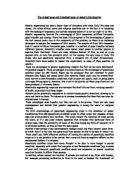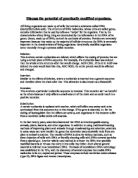You can find genetically engineered organism fairly common in genetically modified foods, such as Bt corn. Bt corn is a genetically modified corn plant. It is pest resistant to common borer species such as the European common borer. Damage from these pests lower crop yields by 5 - 10% annually. It was genetically modified by the insertion of the bacteria Bacillus thuringiensis into the DNA of the corns’ embryo. This can also been seen done to tobacco, tomato and cotton plants. The Bt corn offers a pest resistance in the exact same way that the original bacteria did. The Bt gene creates a protein which is an insoluble crystal in the plant. This crystal is toxic and it kills the borer when it eats the plant. This has advantages such as there is a large amount of pesticide being used to control the borers in the corn crops. Such pesticides need to be sprayed at certain and times with the appropriate weather conditions, so that there is minimal drift and wash off by rain. By the use of the Bt gene there will be a dramatic decrease in the amount of pesticide being used. Also the different strains of the Bt gene can be used meaning that the plants produced can be modified to kill a specific pest.
However there is also a disadvantage to the Bt gene. Some studies have shown that the Bt gene isn’t as specific as it was originally thought to be. This suggests that other insects are also being affected by the properties of the Bt gene. GM are known to be pesticide-resistant that kill of the pest. Though some individuals have also been know to be resistant to the pesticide in the plant. If this resistance is dominant then their offspring will also be resistant. Farmers are now being advised to plant 20% of their acreage in non - Bt corn to main diversity in the pest population.
While GM animals may be easy to control and contain when released onto pasture, GM plants are quite different. GM plants produce seeds and pollen that can be very fine and travel large distances, transported by insects and wind. The question is: if a problem becomes obvious, can contamination from a released GM plant be reversed?
Risk assessments observe the benefits and risk of a proposal. The process of this proposal will depend on the risk and benefits. It is possible to say that the risks on environmental issues such as the Bt corn are to a certain degree unknown and the benefits are to the minimal or can be achieved by lower risk methods.
There is also then the GM sheep and the human gene. This is where sheep have been genetically modified so that they are able to produce human protein. This is being researched by British-based Company PPL Therapeutics Ltd in New Zealand. This was done by taking a human gene from a Danish woman that was then inserted into the DNA of a sheep. In the sheep, it will then be expressed and the protein alpha-1-antitryspin produced by the sheep in its milk. The advantages to this use of genetic modification are that there is some evidence that the protein has the potential to treat cystic fibrosis and emphysema. The transgenic sheep would provide a source of this protein to sufferers. Similarly the technology that is being used to create this protein could also be used to create similar human proteins. Though New Zealand Environmental Risk Authority’s Maori, advisory group reported that some Maori found the insertion of human genetic material into other species culturally offensive and desirable.
Socially and culturally there are many disadvantages to genetically modified organisms, especially in these circumstances like the GM sheep and human gene. Cultural values strongly disagree. When transgenic species are formed, genes are transformed from one species to another. Various beliefs believe that species are separate entities and have their own spirits. They also believe that humans should not interfere with ‘nature’. By creating or modifying plants and animals scientist are ‘playing god’, therefore mixing of these spirits is to them unacceptable. Some beliefs go to the extreme where they are prohibited from eating certain types of meat. With GM foods, can there really be a guarantee that this tomato your about to eat does contain a pig gene? This is a major issue for The New Zealand Maori and Human genes, as stated above. Again in the long run the consequences or effects of this are yet unknown. Though there are advantages to way this issue up, that disease could be prevented by detecting people/animals and plants that are genetically prone to certain hereditary diseases, also infectious disease can be treated by implanting genes that code antiviral proteins specific to each antigen. Genetic Engineering also has the potential to increase genetic diversity, and produce more variant alleles which could also be crossed over and implanted into other species. It is possible to alter the genetics of wheat plants to grow insulin for example.
Not only are there environmental, health, social and cultural disadvantages there are also disadvantages economically which overweigh the advantages. Such as loss of market, as products in the global economy must meet markets needs. A proportion of customers actively purchase non- GM produce. Any company or country that does not meet those needs could lose their markets or market share. Also there is then contamination of organic farming. Organically farmed products have a market niche. Contamination (or supposed contamination) of organic product could lead loss of this market. This is purely on the basis from the organic industry's perspective, GMF offers environmental disadvantages. The major concern is that genetic engineering could permanently alter ecosystems. Once genetically altered plants and animals are introduced into the environment, they may endanger species and potentially reduce biological diversity. Studies already have confirmed there are grounds for this concern. A Cornell University study showed that, in lab experiments, pollen from Bacillus thuringiensis (Bt)-engineered corn killed monarch butterfly larvae. It also is predicted that pollen from a genetically engineered plant resistant to herbicide might jump to other plants, via bees or the wind, and spawn superweeds, particularly when the genetically engineered plants have wild, weedy relatives. In fact, this has already happened in Canada with canola.







